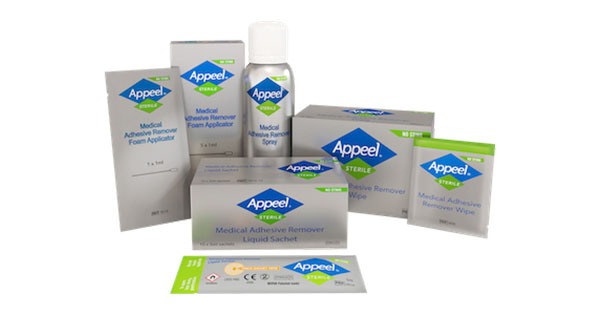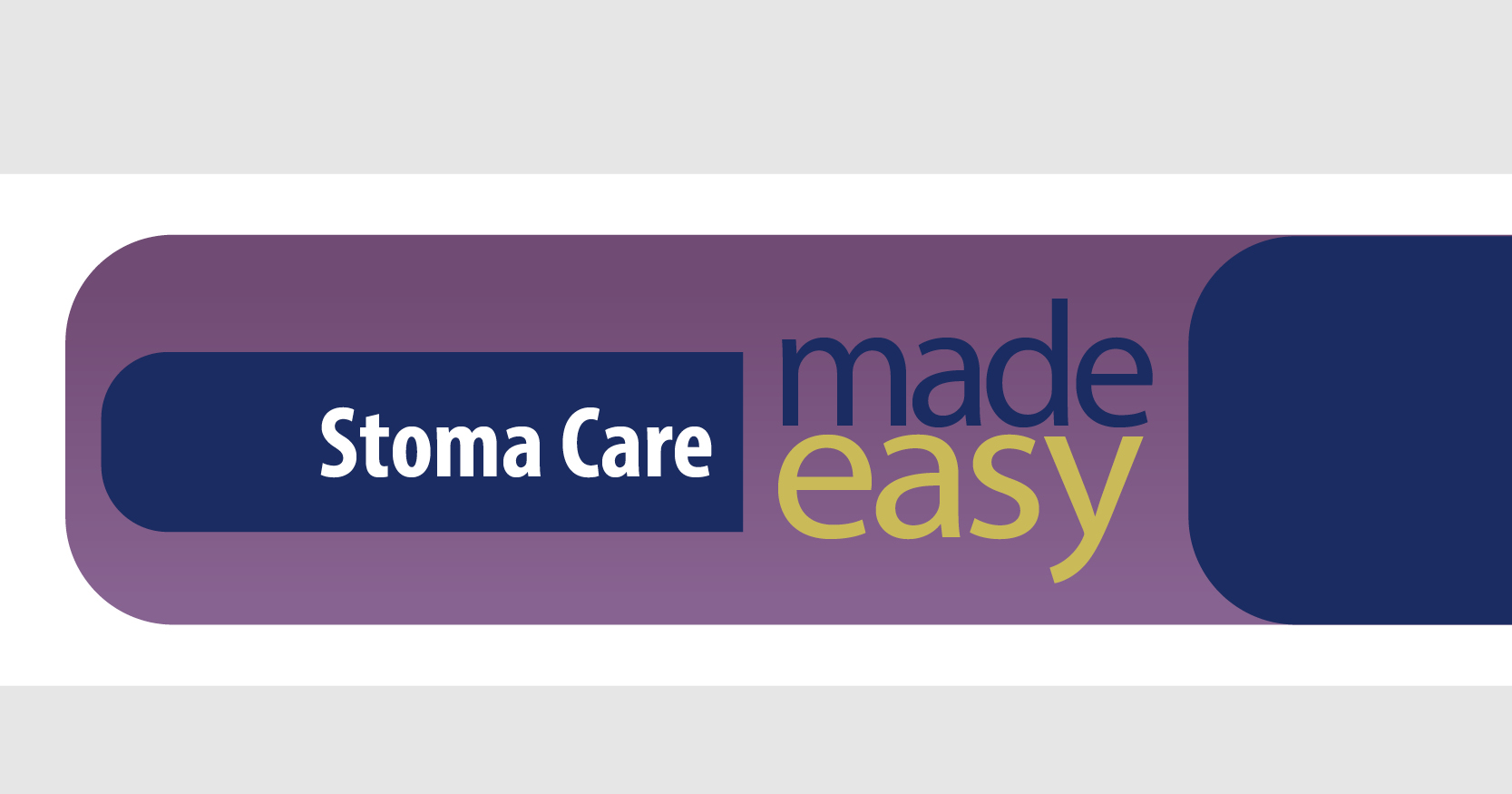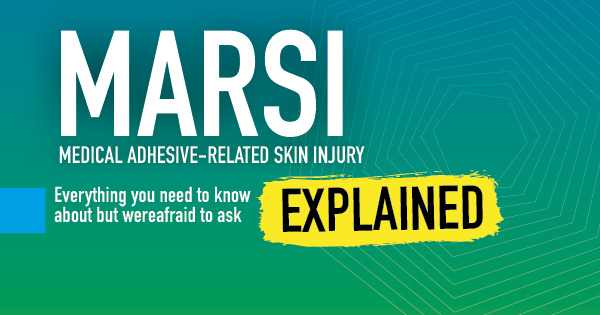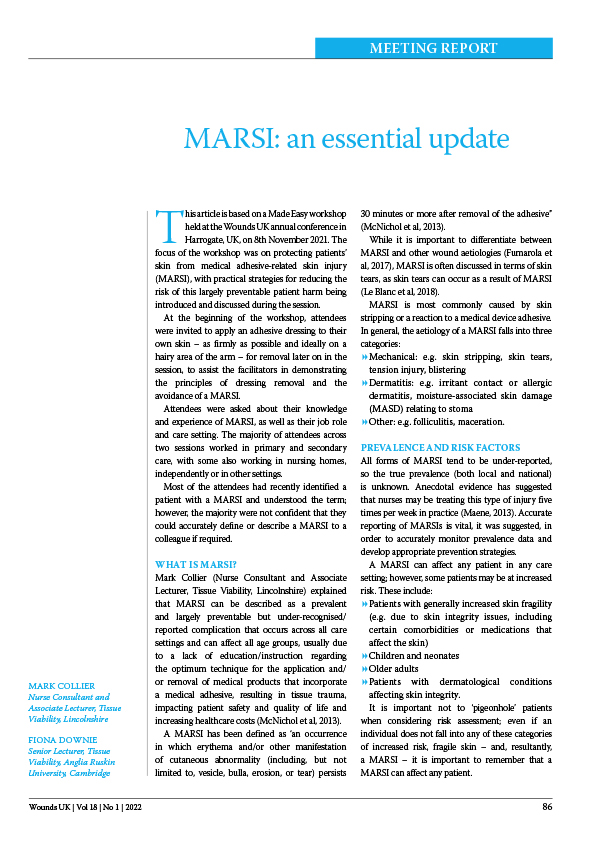This article is based on a Made Easy workshop held at the Wounds UK Annual Conference in Harrogate, UK, on 6th November 2023. The workshop and this report were sponsored by CliniMed. The focus of the workshop was on what a good skincare regimen looks like to prevent and manage medical adhesive-related skin injury (MARSI).
At the beginning of the workshop, attendees were invited to apply an adhesive dressing to their own skin — as firmly as possible and ideally on a hairy area of the arm — for removal later in the workshop, to help facilitators demonstrate good techniques for dressing removal and MARSI prevention.
A MARSI is damage to the skin that may occur when a product that contains a medical adhesive (e.g. tapes, dressings, electrodes or medication patches) is not appropriately selected, applied or removed (Fumarola et al, 2020). This can lead to the removal of skin layers, ultimately causing severe discomfort and pain, which negatively impacts the patient’s quality of life (Hofman et al, 2023). Despite being prevalent and largely preventable, MARSIs are often an overlooked and underreported complication that occurs across all care settings and can affect all age groups (McNichol et al, 2013).
The skin
The skin is the body’s largest organ, and it acts as a barrier by limiting water loss from within, playing a crucial role in maintaining the body’s internal hydration. The epidermis, consisting of five layers, is approximately 0.1–0.2mm in depth (Subramanian et al, 2011). The outermost layer of the skin, the stratum corneum, is composed of flattened overlapping cells surrounded by lipids that create a protective seal. The skin also contains natural moisturising factors (NMFs), which draw and retain water in the surface cells, acting as humectants (Moncrieff et al, 2015).
Neonates
Neonatal skin, defined as a baby under 28 days old (NHS England, 2023), although may appear soft and plump, is actually 40-60% thinner (Jackson, 2008), made up of smaller cells and lacks the same cohesion between the dermis and the epidermis than an adult’s skin. This inherent composition makes neonatal skin more permeable, less resistant to injuries and more vulnerable to chemical, physical and microbial influences (Fumarola et al, 2020). Therefore, the repeated removal of medical adhesives can further weaken the barrier function of neonatal skin.
Children
As children mature, so does their skin. However, children’s skin remains thinner and less pigmented than adults’ due to less active melanocytes. Sweat and sebaceous glands are also less active, resulting in a relatively weaker hydrolipid film and protective acid mantle. As children age, their skin gradually matures, and by the age of 12, the structure of their skin and its associated appendages reaches full maturity (King et al, 2013).
Older adults
As people age, the skin often becomes more alkaline in pH, which reduces its effectiveness in preventing pathogens from entering the skin. The papillary region flattens, and capillary areas shrink with age, making older skin more vulnerable to damage. Dry skin becomes more common as the number of NMFs decreases, water-holding capacity decreases and skin integrity generally declines (Kottner et al, 2013).
Good skin care regimen
The objective of a good skin care regimen is to prepare the skin for the application of adhesives that may cause trauma. A good skin care regimen is essential to patient care goes beyond basic nursing practices and serves as a foundation for patient wellbeing. It must be simple to use, accessible to all parties involved (including the patient, carer and healthcare professional), effective, and tailored to individual needs (Fumarola et al, 2020).
It should include using skin protection products and avoiding soaps/alcohol-based products, instead opting for pH-neutral products, keeping both the skin and the patient hydrated, and thinking about nutrition, where nutritional recommendations must be aligned with the patient’s comorbidities and specific needs (Fumarola et al, 2020). The patient’s skin should also be handled with care — patting is more considerate than rubbing the skin dry with traditional hospital towels, which are known for their excessive abrasiveness. A good skin care regimen should also consider clothing and environmental factors, such as a patient wearing too many layers of clothing, which may increase shear and friction forces.
Holistic skin assessment
Before establishing a good skincare regimen and at each application and removal of a medical adhesive (e.g. a dressing or medical device), a holistic skin assessment should be carried out and documented so that other members of the care team can access and evaluate the findings. It should include the following checklist:
- Patient medical history and history of the wound or stoma
- Allergy/sensitivity assessment, including any known/suspected allergies or sensitivities to adhesive materials (Bernatchez and Bichel, 2023). Even if a product has been used for years, it is important to stay vigilant because ingredient formulations can change without any notice
- Reassess: is the medical adhesive-containing device or dressing effective and/or still necessary; if not, replace with a gentler alternative option or remove
- Visual inspection of the skin:
- – Feel the patient’s skin to measure turgor or elasticity
- – Observe for local signs of irritation/damage where adhesive will be or has been applied.
- Pain assessment: use validated scales to quantify pain (Jenkins, 2020), such as the numeric rating scale. It is important to be aware that certain patients, such as the young or those with cognitive impairments, may not be able to report pain accurately.
Medical adhesive-related skin injury
There are three main causes of MARSI: mechanical forces, dermatitis and others [Box 1].
Patient impact of MARSI
MARSI can compromise the skin’s barrier function and cause delayed healing, increased pain, trauma, skin injury and an increased risk of wound infection, potentially leading to sepsis or morbidity (Fumarola et al, 2020).
Medical adhesives
Medical adhesives are unavoidable and found in most wound dressings and devices. Each type of medical adhesive has a different strength depending on the intended use. Therefore, understanding the unique properties of adhesives is important for making informed decisions about dressing selection and removal methods, both of which have an impact on patient comfort and skin integrity.
Silicone-based adhesives are known for being gentler on the skin. They offer consistent adhesion while causing less trauma during removal and, therefore, are a preferred choice for adhesive applications in healthcare. However, in cases where strong adhesion is required, they may not be the best option because the dressing or device may not remain in place long enough to provide the full therapeutic effect (Godbey and Kinoshita, 2021).
Acrylic-based medical adhesives, on the other hand, have a strong adhesive bond that strengthens over time, which is useful when applying medical devices that must adhere for a long period of time. However, their removal can pull on the skin, cause a MARSI and be traumatic on removal (Godbey and Kinoshita, 2021). Before attempting to remove an acrylic adhesive dressing, determine how long the dressing has been on the patient as this information aids in developing a minimally invasive removal strategy, such as using medical adhesive removers.
Appeel Sterile Medical Adhesive Removers
Appeel Sterile Medical Adhesive Remover (CliniMed) is a sterile silicone medical adhesive that is designed to facilitate the quick and easy removal of dressings and other adhesive products, while simultaneously reducing discomfort and preventing MARSIs.
Appeel Sterile is the only range of fully sterile medical adhesive removal products, making them ideal for use in wound care, as they can be used on intact or injured skin. It is especially beneficial for patients at significant risk of infection, such as those with open wounds, intravenous access sites/central lines, and immunocompromised/suppressed individuals — e.g. people with diabetes.
It is easy to use and is available in a range of product formulations [Table 1] which help facilitate use in a range of wound aetiologies and clinical scenarios. It’s fast drying, leaves no residue and no-sting formulation.
When Appeel Sterile comes into contact with the adhesive of a dressing or device, it temporarily changes the surface energy of the skin, disrupting the adhesive properties between the skin and device and loosening the bond without compromising the surrounding area and eventually removing the adhesive.
During the workshop, Fiona Downie and Rachel Allaway discussed best practice (Fumarola et al, 2020) and the ‘do’s’ and ‘don’ts’ for applying and removing medical dressings or devices, see Table 2 for more information.
Case studies
During the workshop, Rachel Allaway presented two case studies of patients under the age of six, demonstrating various types of MARSI. Fictional examples based on two of the cases are presented below. Rachel Allaway asserted that MARSI incidents are often avoidable and can be very distressing for parents and carers.
Case study 1
A 4-year-old was admitted for cardiac surgery. Post-operatively, the patient was transferred to the intensive care unit while intubated. An IV dressing was applied to secure the right internal jugular neckline in theatre during the procedure, as per trust policy. However, upon removal, the patient exhibited significant MARSI, which was caused by poor positioning of the dressing in theatre, resulting in friction at the dressing edges. Additionally, significant red markings from previous ECG electrodes were observed on the patient’s chest.
When speaking to the patient’s family, it was found that the patient had sensitive skin and had previously experienced painful MARSIs on a number of occasions, although this wasn’t documented in the patient’s medical history.
Considering the patient’s history of MARSI and sensitivity to dressings, the clinical team prioritised managing post-operative dressings to ensure optimal wound care while minimising the risk of additional skin injuries.
Case study 2
A 13-month-old was admitted for respiratory issues, which required the use of non-invasive ventilation, nasogastric feeds, and continuous monitoring of oxygen saturation — all of which require adhesives for securement. This patient suffered a MARSI to their cheek and foot from the device dressings, despite the use of a medical adhesive remover.
The patient had a documented history of dressing sensitivity and was currently being evaluated for a potential diagnosis of eczema. Eczema is known to cause skin sensitivity and can exacerbate reactions to certain materials, including dressings.
Considering the patient’s history of MARSI and sensitivity to dressings, the clinical team prioritised using dressings that were gentle to the skin and didn’t exacerbate skin reactions.
Conclusion
The workshop concluded with an interactive Q&A session, during which the challenges that practice nurses may face in prescribing specific products or treatments were acknowledged. Attendees were encouraged to initiate open and informative dialogues with their GPs, using visual aids such as pictures to illustrate the importance of certain interventions in patient care.
Overall, Fiona Downie and Rachel Allaway delivered a comprehensive understanding of the significance of maintaining good skin care practices, particularly for paediatric patients. Their presentations emphasised the importance of preventing MARSI and highlighted the use of sterile medical adhesive removal products such as Appeel Sterile for improved patient outcomes.





